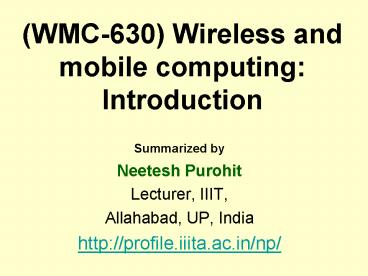WMC630 Wireless and mobile computing: Introduction PowerPoint PPT Presentation
1 / 13
Title: WMC630 Wireless and mobile computing: Introduction
1
(WMC-630) Wireless and mobile computing
Introduction
- Summarized by
- Neetesh Purohit
- Lecturer, IIIT,
- Allahabad, UP, India
- http//profile.iiita.ac.in/np/
2
Various streams in wireless/mobile domain
- Mobile Communication
- (Developing wireless n/w e.g. WLAN, WLL, GSM,
bluetooth etc and related protocols for their
proper working) - Mobile Computing
- (Developing applications for wireless networks
e.g. SMS, hello tunes etc) - Pervasive Computing
- (Developing context aware applications for
wireless networks)
3
Requirements of the course
- Fundamentals of digital comm. theory
- Fundamentals of antenna theory
- Modes of propagation in space
- Fundamentals of Computer n/w
- (layered architecture, protocols, service
primitives, service types, multiple access etc.)
4
The syllabus
- Unit I
- Basic concepts of communication and antenna
theory, Various modes of wireless transmission,
Multiple access techniques, Spread spectrum
techniques, Capacity allocation in satellite
communication. - Unit II
- Principles of cellular mobile systems -
Architecture, Channel assignment, Interference
and system capacity, Repeaters, Cell sectoring,
Cell splitting, Microcell zone concept, Erlang
B and Erlang C formula, handoff considerations,
Prioritizing handoffs. - Unit III
- Large scale path loss models, Small scale fading
and multipath, Modulation techniques for mobile
communication, Equalization, Diversity
5
- Unit IV
- Speech coding techniques, Global System for
mobile (GSM), GPRS, EDGE, - Unit V
- Mobile IP, WAP, DECT Cordless systems, IS-95
(CDMA Mobile) - Unit VI
- Wireless LAN and IEEE 802.11, Fixed WLL and
802.16 standard, UMTS, cdma2000, SS7, Bluetooth
technology
- Text Book
- (i) Wireless Communication T S Rappaport PE
- (ii) Wireless Communication and networks W
Stallings PE - Reference books
- 1. Mobile cellular Telecomm W C Y Lee MH
- 2. Mobile Communications Schiller PE
- 3. Wireless and Mobile network Architecture Y B
Lin JW - 4. Fundamentals of mobile Pervasive computing
F A delstein TMH - 5. UMTS The fundamentals B Walke JW
- 6. GSM, GPRS and EDGE Performance T Halonen JW
6
The Architecture of cellular network
7
Figure 1.6 Timing diagram illustrating how a
call to a mobile user initiated by a landline
subscriber is established.
8
Figure 1.7 Timing diagram illustrating how a
call initiated by a mobile is established.
9
Evolution of cellular system
- In 1946, the first mobile telephone service was
introduced in 25 American cities. - Each system used a single, high powered
transmitter and large tower to cover distances
over 50 Km with 120Khz RF bandwidth half duplex
channels. - Problems
- Bulky mobile unit
- low battery life
- poor service performance (high blocking rate,
inefficient spectrum utilization)
10
The solutions
- Cellular architecture
- Hexagonal cells (min BS, easier HO)
- Very high blocking and dropping rate
- Frequency reuse concept (improved blocking,
cochannel interference) - Cluster size (N) i2j2ij
- Introduction of handoff (improved dropping)
11
Analog cellular system
- In 1983, first analog cellular system was
deployed in Chicago, USA with 30Khz RF bandwidth
full duplex channels (first generation system).
12
Second generation systems
- In 1990, GSM was introduced by European countries
which supports 8 users in 200Khz RF bandwidth (25
khz per user) - In 1991, the US Digital Cellular system (IS- 136)
was installed which supports 3 users in 30 khz RF
bandwidth ( 10Khz per user) - In 1993, Qualcomm developed an CDMA mobile system
(IS-95).
13
Cellular service in India
- 31st July 1995, Indias first mobile service was
launched in Calcutta. - It was a GSM network (why India adopted GSM?)
- Reliance group had launched first CDMA service in
India.

